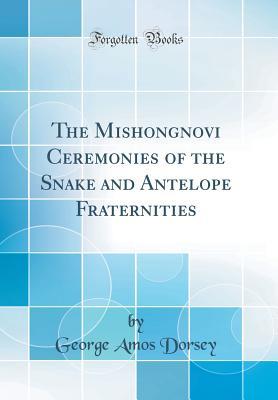Read The Mishongnovi Ceremonies of the Snake and Antelope Fraternities (Classic Reprint) - George Amos Dorsey | ePub
Related searches:
The Mishongnovi ceremonies of the snake and antelope
The Mishongnovi Ceremonies of the Snake and Antelope Fraternities (Classic Reprint)
The Mishongnovi ceremonies of the Snake and Antelope
The Mishongnovi Ceremonies Of The Snake And Antelope
1902 The Mishongnovi Ceremonies Of The Snake and Antelope
Snake Dancer - Edward S. Curtis and The North American Indian
Back to the plains at the U.S. Capitol--Hopi Indians from
The Traditions of the Hopi: 11. The Origin of Some
snake-dance - definition and meaning - Wordnik
Voth, H. R. (Henry R.), 1855-1931 The Online Books Page
Kiva and Katsina
The Origin of Some Mishongnovi Clans - Ya-Native
David Halbach Watercolor The Eddie Basha Collection
Anthropology Publications Issued by The Field Museum of
The Origin of Some Mishongnovi Clans - ya-native.com
Hopi Pueblo of Oraibi, Arizona. The Flute Dance of the Hopi
HOPI NATION - Beyond the Mesas
Hopi Indian Rituals - Native Jewelry and Art
Mishongnovi, Arizona The Tony Hillerman Portal
File:Spectators at the Hopi Indian village of Mishongnovi for
NPS Publications: Preliminary Report on the Ethnography of
Books by George Amos Dorsey (Author of Traditions of the Caddo)
Dances with Snakes: The Real Reason for the Hopi Snake Dance
4583 2276 94 4139 1903 1748 598 592 4406 2187 590 470 2199 881 1236 797 3452 1024 3395 1356 1562 4351 3671 1030 953 1196 3748 818 300 1937 3431 1526
Most of the religious and ceremonial activities originate from shungopavi, however sipaulovi.
Native american painting - hopi pueblo snake dance ceremony - raymond naha - a ceremonial, symbolic representation, a prayer for rain - priests carrying.
Snake knot� the snake knot is a nice base for a zipper pull, lanyard, key ring fobthe overhand, overhand stopper knot goes well with it and the ends can be trimmed close to the knot 3,692 3 the snake knot is a nice base for a zipper pull,.
According to sik'ánakpu the earlier clans came to mishóngnovi as follows: the parrot and crow clans, who had the blue flute cult and the village chief. The bear clan, who brought the antelope altar now used in the snake ceremony. The crane and eagle clan brought the drab flute and maraú cult, and had the village crier.
Many rituals which are performed by the hopi indians as part of their culture, including the niman cachina ritual dance, wedding, birth, death and snake rituals�.
George amos dorsey - the mishongnovi ceremonies of the snake and antelope fraternities. George amos dorsey - the mishongnovi ceremonies of the snake and antelope fraternities.
Abstract: a collection of 77 photographs by earle robert forrest (1883-1969) documenting the dances and rituals of hopi native americans in the villages of oraibi and mishongnovi, arizona, in 1906-1908. The images primarily depict the snake race, snake dance, and blue flute dance ceremonies, but there are also candid views of people in their.
Each of the mesas has its own cultural and spiritual significance to the hopi people, and similarly, each village maintains its own traditions and rituals even while.
The mishongnovi ceremonies of the snake and antelope fraternities.
Wedding ceremonies are the most important element of the entire occasion. Advertisement whether you hold your wedding indoors or out, summer or winter, formal or casual, the ceremony.
Snakes are carnivorous elongate reptiles that are covered in scales and unlike many reptiles, they lack legs. Advertisement snakes have a long, flexible body that is covered with dry scales.
Curtis for sale - buy real museum quality photographic prints online at incredible prices! gable whiteamerican indians portrait of a hopi snake.
Mishongnovi, hopi indian reservation, arizona, august 17, 1907. Box 1, item 18 a snake racer coming up the trail to the top of the mesa during the snake race at mishongnovi, during the early morning of the day of the public snake dance. Mishongnovi, hopi indian reservation, arizona, august 18, 1907.
The mishongnovi ceremonies of the snake and antelope fraternities / by 1868-1931.
This entire ceremony is to worship hopi ancestors and to help bring rain.
For thousands of years the hopi tribe of northern arizona has performed a secretive, sacred ceremony that embodies the manifold and richly evocative archetypal nature of the serpent. In modern times the so-called snake dance (tsu’tiki or tsu’tiva) has gained notoriety, partly because its participants put live snakes in their mouths and wrap them around their necks.
Do you know how to identify garden snakes? find out how to identify garden snakes in this article from howstuffworks. Advertisement garter snakes, sometimes called garden snakes, are common in north america and central america.
Description a collection of 77 photographs by earle robert forrest (1883-1969) documenting the dances and rituals of hopi native americans in the villages of oraibi and mishongnovi, arizona, in 1906-1908.
The snake dance, best known of hopi ceremonies and one of the most spectacular of all primitive performances, is a biennial, sixteen-day rite conducted by the snake and antelope fraternities as a dramatized prayer for rain.
The mishongnovi are a group of people from one of three hopi villages in arizona. This work discusses the ceremony of the 'snake and antelope fraternities'. Published by the field columbian museum as publication number 66 from their anthropological series.
Dorsey making notes with luke as interpreter and carpenter at camera, mishongnovi snake ceremony.
Garter snakes are slender to moderately built snakes that usually have three yellowish or greenish stripes running the length of their bodies. They average garter snakes are slender to moderately built snakes that usually have three yellowi.
Sep 3, 1990 in this primitive hopi indian village of stone huts and mud thatched roofs, the annual snake dance is a sacred ritual in which men and boys.

Post Your Comments: